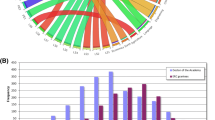Abstract
This article analyses the evolution in the number of authors of scientific publications in computer science (CS). This analysis is based on a framework that structures CS into 17 constituent areas, proposed by Wainer et al. (Commun ACM 56(8):67–63, 2013), so that indicators can be calculated for each one in order to make comparisons. We collected and mined over 200,000 article references from 81 conferences and journals in the considered CS areas, spanning a 60-year period (1954–2014). The main insights of this article are that all CS areas witness an increase in the average number of authors, in every decade, with just one slight exception. We ordered the article references by number of authors, in ascending chronological order and grouped them into decades. For each CS area, we provide a perspective of how many groups (1-author papers, 2-author papers and so on) must be considered to reach certain proportions of the total for that CS area, e.g., the 90th and 95th percentiles. Different CS areas require different number of groups to reach those percentiles. For all 17 CS areas, an analysis of the point in time in which publications with n + 1 authors overtake the publications with n authors is presented. Finally, we analyse the average number of authors and their rate of increase.


Similar content being viewed by others
Notes
The current paper utilizes only the seed venues indicated by Wainer et al. (2013). These seed venues are the most favoured by researchers, who recognize the seed venues as “central” and “important” to contributed articles to their respective areas. The interested reader could argue that this study could have included all the venues from the longer list in the appendix of the technical report referred to in that paper. To check if the resulting numbers would be significantly different, we experimented performing the study using the longer list of venues for two areas—C+PL and DB. For instance, the average numbers of authors for C+PL are 1.727, 2.129, 2.626 and 3.306, respectively for decades 75–84, 85–94, 95–04 and 05–14. The equivalent numbers from the longer list are 1.747, 2.042, 2.367 and 3.021. Similarly, for DB the average numbers of authors are 1.948, 2.305, 3.183 and 3.792. The equivalent numbers from the longer list are 1.905, 2.255, 2.973 and 3.686. Though the numbers are not exactly the same—as it would be expected—the conclusions to be derived from the longer list are broadly the same as with the seed venues.
Similar conclusions apply to the numbers related to overtakes (Table 3). For C+PL, the years in Table 3 are 1973, 1979, and 2002, while if the longer list of venues is used the years would be 1973, 1979, and 2009.
References
Abt, H. A. (1981). Some trends in American astronomical publications. Publications of the Astronomical Society of the Pacific, 93(553), 269. doi:10.1086/130820.
Bennett, D. M., & Taylor, D. M. (2003). Unethical practices in authorship of scientific articles. Emergency Medicine Journal, 15(1), 263–270. doi:10.1046/j.1442-2026.2003.00432.x.
Biryukov, M., & Dong, C. (2010). Analysis of computer science communities based on DBLP. In M. Lalmas, J. Jose, A. Rauber, F. Sebastiani, & I. Frommholz (Eds.), Research and advanced technology for digital libraries, volume 6273 of LNCS (pp. 228–235). Berlin: Springer. doi:10.1007/978-3-642-15464-5_24.
Cavero, J. M., Vela, B., & Cáceres, P. (2014). Computer science research: More production, less productivity. Scientometrics, 98(3), 2103–2111. doi:10.1007/s11192-013-1178-2.
Cohoon, J. M., Nigai, S., & Kaye, J. (2011). Gender and computing conference papers. Communications of the ACM, 54(8), 72–80. doi:10.1145/1978542.1978561.
Elmacioglu, E., & Lee, D. (2005). On six degrees of separation in DBLP-DB and more. ACM SIGMOD Record, 34(2), 33–40.
Fernandes, J. M. (2014). Authorship trends in software engineering. Scientometrics, 101(1), 257–271. doi:10.1007/s11192-014-1331-6.
Franceschet, M. (2011). Collaboration in computer science: A network science approach. Journal of the American Society for Information Science and Technology, 62(10), 1992–2012. doi:10.1002/asi.21614.
Freyne, J., Coyle, L., Smyth, B., & Cummingham, P. (2010). Relative status of journal and conference publications in computer science. Communications of the ACM, 53(11), 124–132. doi:10.1145/1839676.1839701.
Garousi, V., & Fernandes, J. M. (2016). Highly-cited papers in software engineering: The top 100. Information and Software Technology, 71, 108–128. doi:10.1016/j.infsof.2015.11.003.
Greene, M. (2007). The demise of the lone author. Nature, 450(7173), 1165. doi:10.1038/4501165a.
Gu, Y. (2002). An exploratory study of Malaysian publication productivity in computer science and information technology. Journal of the American Society for Information Science and Technology, 53(12), 974–986. doi:10.1002/asi.10125.
Laender, A., de Lucena, C., Maldonado, J., de Souza e Silva, E., & Zivianim, N. (2008). Assessing the research and education quality of the top Brazilian computer science graduate programs. ACM SIGCSE Bulletin, 40(2), 135–145.
Ley, M. (2009). DBLP—Some lessons learned. In Proceedings of the VLDB endowment (PVLDB 2009) (Vol. 2, Number 2, pp. 1493–1500).
Meyer, B., Choppy, C., Staunstrup, J., & van Leeuwen, J. (2009). Research evaluation for computer science. Communications of the ACM, 52(4), 31–34.
Patterson, D. A. (2004). The health of research conferences and the dearth of big idea articles. Communications of the ACM, 47(12), 23–24. doi:10.1145/1035134.1035153.
Solomon, J. (2009). Programmers, professors, and parasites: Credit and co-authorship in computer science. Science and Engineering Ethics, 15(4), 467–489. doi:10.1007/s11948-009-9119-4.
Vardi, M. Y. (2009). Conferences vs. journals in computing research. Communications of the ACM, 52(5), 5. doi:10.1145/1506409.1506410.
Wainer, J., Eckmann, M., Goldenstein, S., & Rocha, A. (2013). How productivity and impact differ across computer science subareas. Communications of the ACM, 56(8), 67–73. doi:10.1145/2492007.2492026.
Acknowledgements
This work was supported by FCT—Fundação para a Ciência e Tecnologia within the Project Scope UID/CEC/00319/2013.
Author information
Authors and Affiliations
Corresponding author
Rights and permissions
About this article
Cite this article
Fernandes, J.M., Monteiro, M.P. Evolution in the number of authors of computer science publications. Scientometrics 110, 529–539 (2017). https://doi.org/10.1007/s11192-016-2214-9
Received:
Published:
Issue Date:
DOI: https://doi.org/10.1007/s11192-016-2214-9




